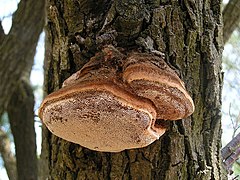Hymenochaetales
| Hymenochaetales | |
|---|---|
 |
|
| Inonotus tamaricis | |
| Scientific classification | |
| Kingdom: | Fungi |
| Division: | Basidiomycota |
| Class: | Agaricomycetes |
| Order: |
Hymenochaetales Oberw. (1977) |
| Families | |
|
Hymenochaetaceae Imazeki & Toki |
|
Hymenochaetaceae Imazeki & Toki
Repetobasidiaceae Jülich
Schizoporaceae Jülich
The Hymenochaetales are an order of fungi in the class Agaricomycetes. The order in its current sense is based on molecular research and not on any unifying morphological characteristics. According to one 2008 estimate, the Hymenochaetales contain around 600 species worldwide, mostly corticioid fungi and poroid fungi, but also including several clavarioid fungi and agarics. Species of economic importance include wood decay fungi in the genera Phellinus and Inonotus sensu lato, some of which may cause losses in forestry. Therapeutic properties are claimed for Inonotus obliquus ("chaga") and Phellinus linteus, both of which are now commercially marketed.
The order was proposed in 1977 to recognize the family Hymenochaetaceae at a higher taxonomic rank. As originally conceived, species within the Hymenochaetales had several morphological features in common, notably brown or brownish basidiocarps (fruit bodies) that turn black in alkali, hyphae lacking clamp connections, and the presence (in most species) of characteristic setae (thick-walled, thorn-shaped cystidia, visible under a hand lens).
...
Wikipedia
